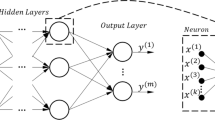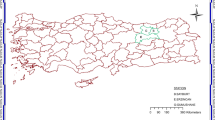Abstract
This study appraises different types of conventional (e.g., GRNN, RBNN, & MLPNN) and modern neural networks (e.g., integrative, inclusive, hybrid, & recurrent) in forecasting daily flow in the Thames River located in the United Kingdom. The models are mathematically, statistically, and diagnostically compared based on the forecasted results for ten different time-series assortments. The results indicate that all the neural network models acceptably forecasted the daily flow rate, with mean values of R2 > 0.92 and RMSE < 18.6 m3/s. Despite the fact that the integrative neural network models slightly acted better in forecasting flow rate (mean values of R2 > 0.94 and RMSE < 15.3 m3/s), they were not as computationally effective as the other applied models.








Similar content being viewed by others
Abbreviations
- ABC:
-
Artificial Bee Colony
- ACF:
-
Autocorrelation Function
- ACO:
-
Ant Colony Optimization
- ANFIS:
-
Adaptive Neuro-Fuzzy Inference System
- ANN:
-
Artificial Neural Network
- ARIMA:
-
AutoRegressive Integrated Moving Average
- DE:
-
Differential Evolution
- DWT:
-
Discrete Wavelet Transform
- ELM:
-
Extreme Learning Machine
- FIS:
-
Fuzzy Inference System
- GA:
-
Genetic Algorithm
- GEP:
-
Gene Expression Programming
- GMDH:
-
Group Method of Data Handling
- IA:
-
Index of Agreement
- LSTM:
-
Long Short-Term Memory
- M:
-
The number of performance measures
- MAE:
-
Mean Absolute Error
- MLPNN:
-
Multi-Layer Perceptron Neural Network
- MLR:
-
Multiple Linear Regression
- MNN:
-
Modular Neural Network
- MODWT:
-
Maximal Overlap Discrete wavelet Transform
- N:
-
The number of the data samples
- NARX:
-
Nonlinear Auto-Regressive model with eXogenous inputs
- NFNN:
-
Neuro-Fuzzy Neural Network
- NSE:
-
Nash-Sutcliffe Efficiency
- PACF:
-
Partial Autocorrelation Function
- PSO:
-
particle swarm optimization
- Q:
-
Daily river flow
- Qf :
-
Forecasted river flow value
- Qo :
-
Measured river flow rate
- R2 :
-
Coefficient of determination
- RBNN:
-
Radial Basis function Neural Network
- RMSE:
-
Root Mean Square Error
- RNN:
-
Recurrent Neural Networks
- RSD:
-
Relative Standard Deviation
- SES:
-
Simple Exponential Smoothing
- SI:
-
Synthesis Index
- Std:
-
The standard deviation
- SVM:
-
Support Vector Machine
- TS:
-
Takagi-Sugeno
- WNN:
-
Wavelet-based Neural Networks
References
Abrahart RJ, See LM, Solomatine DP (2008, 68) Practical hydroinformatics: computational intelligence and technological developments in water applications. Springer Science & Business Media
Adnan RM, Zounemat-Kermani M, Kuriqi A, Kisi O (2021) Machine learning method in prediction streamflow considering periodicity component. In: Intelligent Data Analytics for Decision-Support Systems in Hazard Mitigation. Springer, Singapore, pp 383–403
Azad A, Farzin S, Kashi H, Sanikhani H, Karami H, Kisi O (2018) Prediction of river flow using hybrid neuro-fuzzy models. Arab J Geosci 11(22):718
Banihabib ME, Bandari R, Peralta RC (2019) Auto-regressive neural-network models for long Lead-time forecasting of daily flow. Water Resour Manag 33(1):159–172
Bell VA, Kay AL, Cole SJ, Jones RG, Moore RJ, Reynard NS (2012) How might climate change affect river flows across the Thames Basin? An area-wide analysis using the UKCP09 regional climate model ensemble. J Hydrol 442:89–104
Campolo M, Andreussi P, Soldati A (1999) River flood forecasting with a neural network model. Water Resour Res 35(4):1191–1197
Chau KW (2006) Particle swarm optimization training algorithm for ANNs in stage prediction of Shing Mun River. J Hydrol 329(3–4):363–367
Chen J, Jin Q, Chao J (2012) Design of deep belief networks for short-term prediction of drought index using data in the Huaihe river basin. Math Probl Eng 2012:1–16
Chen L, Guo S (2019) Uncertainty analysis of hydrologic forecasts based on copulas. In: Copulas and Its Application in Hydrology and Water Resources. Springer, Singapore, pp 165–210
Chen XY, Chau KW, Busari AO (2015) A comparative study of population-based optimization algorithms for downstream river flow forecasting by a hybrid neural network model. Eng Appl Artif Intell 46:258–268
Cigizoglu HK, Alp M (2006) Generalized regression neural network in modelling river sediment yield. Adv Eng Softw 37(2):63–68
Darbandi S, Pourhosseini FA (2018) River flow simulation using a multilayer perceptron-firefly algorithm model. Appl Water Sci 8(3):85
Dawson CW, Wilby RL (1999) A comparison of artificial neural networks used for river forecasting. Hydrol Earth Syst Sci 3(4):529–540
Delafrouz H, Ghaheri A, Ghorbani MA (2018) A novel hybrid neural network based on phase space reconstruction technique for daily river flow prediction. Soft Comput 22(7):2205–2215
Ghorbani MA, Khatibi R, Karimi V, Yaseen ZM, Zounemat-Kermani M (2018) Learning from multiple models using artificial intelligence to improve model prediction accuracies: application to river flows. Water Resour Manag 32(13):4201–4215
Ghorbani MA, Zadeh HA, Isazadeh M, Terzi O (2016) A comparative study of artificial neural network (MLP, RBF) and support vector machine models for river flow prediction. Environ Earth Sci 75(6):476
Hochreiter S, Schmidhuber J (1997) Long short-term memory. Neural Comput 9(8):1735–1780
Hong WC (2008) Rainfall forecasting by technological machine learning models. Appl Math Comput 200(1):41–57
Hussain D, Ahmed Khan A (2020) Machine learning techniques for monthly river flow forecasting of Hunza River, Pakistan. Earth Sci Inf 13:939–949
Hussain D, Hussain T, Ahmed Khan A, Asad Naqvi SA, Jamil A (2020) A deep learning approach for hydrological time-series prediction: a case study of Gilgit river basin. Earth Sci Inf 13:915–927
Hyndman RJ, Athanasopoulos G (2018) Forecasting: principles and practice. OTexts, Melbourne https://otexts.org/fpp2
Ikeda S, Ochiai M, Sawaragi Y (1976) Sequential GMDH algorithm and its application to river flow prediction. IEEE Trans Syst Man Cybernet 7:473–479
Imrie CE, Durucan S, Korre A (2000) River flow prediction using artificial neural networks: generalisation beyond the calibration range. J Hydrol 233(1–4):138–153
Keskin ME, Taylan D, Terzi O (2006) Adaptive neural-based fuzzy inference system (ANFIS) approach for modelling hydrological time series. Hydrol Sci J 51(4):588–598
Kisi O, Genc O, Dinc S, Zounemat-Kermani M (2016) Daily pan evaporation modeling using chi-squared automatic interaction detector, neural networks, classification and regression tree. Comput Electron Agric 122:112–117
Li Y, Khan MYA, Jiang Y, Tian F, Liao W, Fu S, He C (2019) CART and PSO+ KNN algorithms to estimate the impact of water level change on water quality in Poyang Lake, China. Arab J Geosci 12(9):287
Mahdavi-Meymand A, Scholz M, Zounemat-Kermani M (2019) Challenging soft computing optimization approaches in modeling complex hydraulic phenomenon of aeration process. ISH J Hydraulic Eng:1–12
Maier HR, Dandy GC (2000) Neural networks for the prediction and forecasting of water resources variables: a review of modelling issues and applications. Environ Model Softw 15(1):101–124
Marsh TJ (2004) The January 2003 flood on the Thames. Weather 59(3):59–62
Najafzadeh M, Barani GA, Hessami Kermani MR (2014) Estimation of pipeline scour due to waves by GMDH. J Pipeline Syst Eng Pract 5(3):06014002
Nash JE, Sutcliffe JV (1970) River forecasting using conceptual models: part 1-a discussion of principles. J Hydrol 10(3):280–290
Niu WJ, Feng ZK (2021) Evaluating the performances of several artificial intelligence methods in forecasting daily streamflow time series for sustainable water resources management. Sustain Cities Soc 64:102562
Papacharalampous GA, Tyralis H, Koutsoyiannis D (2019) Comparison of stochastic and machine learning methods for multi-step ahead forecasting of hydrological processes. Stoch Env Res Risk A 33(2):481–514
Quilty J, Adamowski J (2018) Addressing the incorrect usage of wavelet-based hydrological and water resources forecasting models for real-world applications with best practices and a new forecasting framework. J Hydrol 563:336–353
Rajaee T, Nourani V, Zounemat-Kermani M, Kisi O (2010a) River suspended sediment load prediction: application of ANN and wavelet conjunction model. J Hydrol Eng 16(8):613–627
Rajaee T, Shahabi A (2016) Evaluation of wavelet-GEP and wavelet-ANN hybrid models for prediction of total nitrogen concentration in coastal marine waters. Arab J Geosci 9(3):176
Sak H, Senior A, Beaufays F (2014) Long short-term memory recurrent neural network architectures for large scale acoustic modeling. In: Fifteenth annual conference of the international speech communication association
Santos CAG, Kisi O, da Silva RM, Zounemat-Kermani M (2018) Wavelet-based variability on streamflow at 40-year timescale in the Black Sea region of Turkey. Arab J Geosci 11(8):169
Saraiva SV, de Oliveira Carvalho F, Santos CAG, Barreto LC, Freire PKDMM (2021) Daily streamflow forecasting in Sobradinho reservoir using machine learning models coupled with wavelet transform and bootstrapping. Appl Soft Comput 102:107081
Schaller N, Kay AL, Lamb R, Massey NR, Van Oldenborgh GJ, Otto FE et al (2016) Human influence on climate in the 2014 southern England winter floods and their impacts. Nat Clim Chang 6(6):627–634
Shahriar MDS, Kamruzzaman M, McCulloch J, Beecham S (2016) Multiple step ahead river flow modelling for south east tasmanian aquaculture. Earth Sci Inf 9:271–279
Shoaib M, Shamseldin AY, Khan S, Khan MM, Khan ZM, Sultan T, Melville BW (2018) A comparative study of various hybrid wavelet feedforward neural network models for runoff forecasting. Water Resour Manag 32(1):83–103
Srinivas VV, Srinivasan KJWRR (2001) A hybrid stochastic model for multiseason streamflow simulation. Water Resour Res 37(10):2537–2549
Tsoukalas I, Papalexiou S, Efstratiadis A, Makropoulos C (2018) A cautionary note on the reproduction of dependencies through linear stochastic models with non-gaussian white noise. Water 10(6):771
Tyralis H, Papacharalampous G, Langousis A (2019) Super learning for daily streamflow forecasting: large-scale demonstration and comparison with multiple machine learning algorithms. arXiv preprint arXiv:1909.04131
Vieira AC, Garcia G, Pabón RE, Cota LP, de Souza P, Ueyama J, Pessin G (2020) Improving flood forecasting through feature selection by a genetic algorithm–experiments based on real data from an Amazon rainforest river. Earth Sci Inform:1–14
Wang L, Kisi O, Zounemat-Kermani M, Zhu Z, Gong W, Niu Z, Liu H, Liu Z (2017) Prediction of solar radiation in China using different adaptive neuro-fuzzy methods and M5 model tree. Int J Climatol 37(3):1141–1155
Yaseen ZM, El-Shafie A, Afan HA, Hameed M, Mohtar WHMW, Hussain A (2016) RBFNN versus FFNN for daily river flow forecasting at Johor River, Malaysia. Neural Comput Appl 27(6):1533–1542
Yaseen ZM, Ebtehaj I, Bonakdari H, Deo RC, Mehr AD, Mohtar WHMW et al (2017) Novel approach for streamflow forecasting using a hybrid ANFIS-FFA model. J Hydrol 554:263–276
Zadeh MR, Amin S, Khalili D, Singh VP (2010) Daily outflow prediction by multi layer perceptron with logistic sigmoid and tangent sigmoid activation functions. Water Resour Manag 24(11):2673–2688
Zounemat-Kermani M (2012) Hourly predictive Levenberg–Marquardt ANN and multi linear regression models for predicting of dew point temperature. Meteorog Atmos Phys 117(3–4):181–192
Zounemat-Kermani M (2014) Principal component analysis (PCA) for estimating chlorophyll concentration using forward and generalized regression neural networks. Appl Artif Intell 28(1):16–29
Zounemat-Kermani M, Mahdavi-Meymand A (2019) Hybrid meta-heuristics artificial intelligence models in simulating discharge passing the piano key weirs. J Hydrol 569:12–21
Zounemat-Kermani M, Kisi O, Rajaee T (2013) Performance of radial basis and LM-feed forward artificial neural networks for predicting daily watershed runoff. Appl Soft Comput 13(12):4633–4644
Zounemat-Kermani M, Matta E, Cominola A, Xia X, Zhang Q, Liang Q, Hinkelmann R (2020) Neurocomputing in surface water hydrology and hydraulics: a review of two decades retrospective, current status and future prospects. J Hydrol 125085
Acknowledgments
The first author would like to express his gratitude to the Alexander von Humboldt Foundation for providing financial support for this research project within the framework of the Return Fellowship program.
Author information
Authors and Affiliations
Corresponding author
Ethics declarations
Conflict of interest
The authors certify that they have NO affiliations with or involvement in any organization or entity with any financial interest (such as honoraria; educational grants; participation in speakers’ bureaus; membership, employment, consultancies, stock ownership, or other equity interest; and expert testimony or patent-licensing arrangements), or non-financial interest (such as personal or professional relationships, affiliations, knowledge or beliefs) in the subject matter or materials discussed in this manuscript.
Additional information
Communicated by: H. Babaie
Publisher’s note
Springer Nature remains neutral with regard to jurisdictional claims in published maps and institutional affiliations.
Rights and permissions
About this article
Cite this article
Zounemat-Kermani, M., Mahdavi-Meymand, A. & Hinkelmann, R. A comprehensive survey on conventional and modern neural networks: application to river flow forecasting. Earth Sci Inform 14, 893–911 (2021). https://doi.org/10.1007/s12145-021-00599-1
Received:
Accepted:
Published:
Issue Date:
DOI: https://doi.org/10.1007/s12145-021-00599-1




